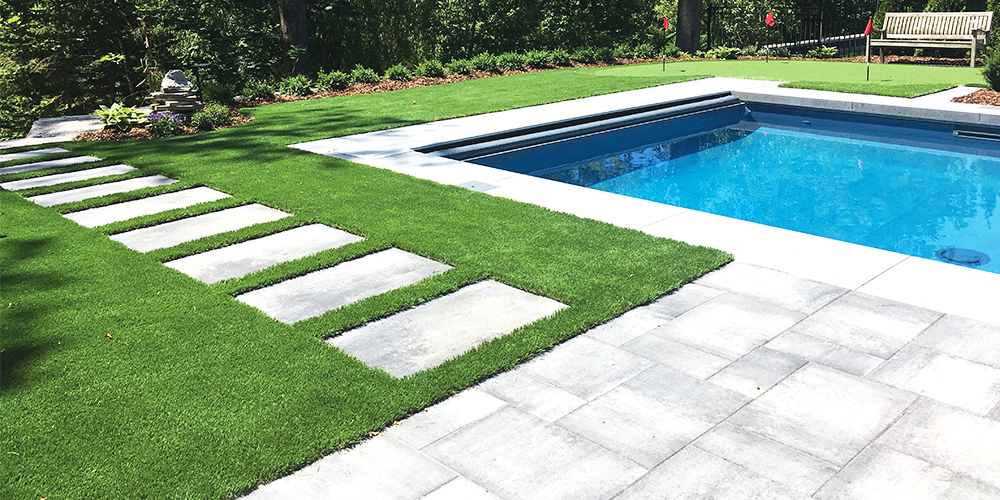Look Into the Environmental Perks of Opting for Artificial Turf Solutions
The fostering of fabricated lawn options presents an engaging chance to address pushing environmental difficulties. By dramatically minimizing water usage and decreasing the application of damaging chemicals, these choices not only promote sustainable landscaping yet also safeguard neighborhood ecosystems.
Water Conservation Conveniences
One of the most substantial advantages of fabricated lawn is its capability to save water. In comparison, artificial grass does not need watering, significantly decreasing the overall need for water resources.
By eliminating the demand for regular watering, fabricated lawn contributes to lasting landscape practices and assists reduce the ecological impact of too much water intake. Moreover, the conservation of water encompasses the reduction of runoff, which can lead to dirt disintegration and waterway air pollution.
In addition, the installation of synthetic grass allows homeowners and communities to assign water resources much more effectively, focusing on essential usages such as alcohol consumption water and agriculture. The shift towards synthetic lawn not just advertises liable water use yet likewise aligns with more comprehensive ecological goals focused on preserving natural deposits.
As areas progressively focus on sustainability, the water conservation benefits of synthetic grass present an engaging case for its fostering in business and property landscape design jobs.
Lowered Chemical Usage
The change to man-made grass considerably reduces the dependence on chemical therapies typically used in natural turf maintenance. Standard grass monitoring normally involves the application of fertilizers, herbicides, and pesticides to promote development and control pests. These chemicals can pose dangers to human wellness, local wild animals, and the setting, adding to dirt and water contamination.
In contrast, artificial turf eliminates the demand for these hazardous compounds. By reducing the launch of artificial compounds into the ecosystem, man-made grass promotes much healthier dirt and water systems.
Additionally, the absence of chemical overflow connected with synthetic grass setups aids secure regional waterways from air pollution, supporting marine life and maintaining biodiversity. Phoenix turf companies. As areas significantly prioritize sustainable techniques, choosing synthetic grass provides a sensible solution that aligns with ecological conservation objectives. Via this change, homeowner can delight in lush eco-friendly spaces without jeopardizing ecological health, paving the means for a more lasting future
Reduced Carbon Impact

Additionally, the setup of synthetic lawn can cause substantial water preservation. All-natural lawns require significant amounts of water for watering, which not only includes in the carbon footprint related to water removal and treatment however likewise stress neighborhood water resources. On the other hand, artificial lawn requires minimal upkeep, requiring no watering, therefore considerably reducing water usage and its associated power prices.
Additionally, the longevity of synthetic grass adds to its lower carbon influence. With a life expectancy of approximately 15 years or more, the requirement for try this frequent replacements is decreased, leading to less waste and lower power usage in manufacturing and disposing of typical grass options. Overall, artificial lawn provides a lasting choice for eco aware landscaping.
Habitat Preservation
Environment conservation is a vital consideration in the dispute over landscaping choices, specifically when comparing synthetic grass to all-natural lawn. Natural lawn lawns typically require extensive maintenance, including the usage of pesticides, fertilizers, and herbicides, which can negatively impact neighborhood environments. These chemicals can seep into the dirt and rivers, hurting indigenous view publisher site vegetation and animals and disrupting neighborhood environments.
Artificial grass eliminates the demand for unsafe chemicals, consequently securing nearby wild animals and maintaining the honesty of bordering environments. The installment of artificial lawn can lead to the conversion of previous grass locations right into more biodiverse landscapes, such as pollinator gardens or indigenous plant areas, which can support regional wildlife.
Eventually, the shift to artificial grass not only conserves water and lowers maintenance efforts however likewise fosters a much more unified connection between human activities and the native environment, promoting environment conservation in the process.
Long-Term Sustainability
Lasting sustainability is an essential consider reviewing the benefits of synthetic grass over conventional lawn lawns. One of the most significant advantages of fabricated turf is its resilience; it can last up to 15-20 years with very little maintenance, whereas all-natural lawn needs constant reseeding and substitute. This durability lowers the need for consistent sources, such as water, fertilizers, and chemicals, which are crucial for keeping a healthy yard lawn.
In addition, artificial turf adds to a reduction in carbon emissions connected with yard treatment devices. Standard lawns typically need gas-powered lawn mowers, leaners, and blowers, every one of which add to air contamination. Arizona turf. On the other hand, fabricated lawn removes the requirement for such tools, promoting a cleaner setting
In addition, the manufacturing of artificial grass progressively makes use of recycled materials, boosting its sustainability profile. As suppliers adopt green methods, the environmental impact of synthetic grass continues to reduce.

Verdict
The fostering of synthetic grass remedies provides considerable environmental benefits, go right here consisting of substantial water preservation, lowered dependence on hazardous chemicals, and a lower carbon footprint. Additionally, synthetic grass aids in protecting all-natural environments by minimizing land disturbance and promoting lasting sustainability through making use of durable products. Jointly, these elements highlight the capacity of synthetic grass to add favorably to environmental health and offer a practical alternative to traditional landscaping methods in an increasingly resource-conscious world.
In comparison, man-made grass does not need watering, significantly reducing the general need for water sources. By minimizing the release of artificial compounds into the ecosystem, synthetic turf advertises much healthier dirt and water systems.
In addition, the installation of man-made lawn can result in substantial water conservation. In comparison, synthetic turf needs marginal upkeep, requiring no watering, therefore considerably lowering water use and its associated energy prices.
